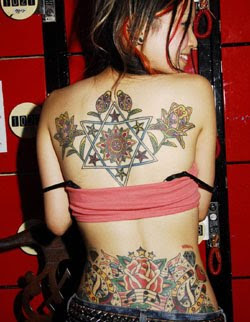


"The cute, fashionable ones, they are OK to show whenever."
That sentiment is now well established in a country that has long felt conflicted about tattoos, often revealing its feelings in officially sanctioned public prejudice.
In many ways, women are leading the way. Tattoos on starlets such as Namie Amuro and Ayumi Hamasaki are thought of as stylish by a younger, pop culture- hungry generation, while overseas fashion trends have made "getting ink" much less of a radical lifestyle choice.
U.S. reality-TV shows set in tattoo studios have made the art form so popular there that tattoo artists are baffled at its new high profile. The Journal of the American Academy of Dermatology (2006) found in a survey that 24 percent of its respondents between 18 and 50 were tattooed. In Britain, ink shares a similar popularity, especially among women.
"I see more women wearing ink than guys these days," says Neil Dalleywater, the editor of top U.K. tattoo magazine Skin Deep. "It is a big part of the tattooing industry. Women are realizing that tattoos can be very feminine and sexy, and they like it that if a tattoo is in a discrete position, they can either show off their ink or keep it covered.
"Tattoos can also be therapeutic, and many women have wonderful tattoos covering mastectomy and other scars."
Women have a strong presence in the Japanese tattoo industry: Most editors of tattoo magazines are female, and female artists are increasingly common.
"Female artists are popular with girls getting tattooed who don't want to show their skin to a male stranger," said Tattoo Burst magazine editor Miho Kawasaki at a girl-only tattoo convention back in 2006 in Tokyo's trendy Daikanyama area. "They make the process less threatening by using words and concepts that a woman can more easily relate to, such as a tattoo being kawaii (cute)."
Artists such as Nattsu at Osaka's Chopstick studio have entire portfolios of super-kawaii motifs. "I get lots of girls, girls working in the fashion and beauty industries, and gay guys," she says.
Flipping through her colorful book, there are ice-cream cones, toucans, and manga-style pandas that grace the hip bones and ankles of girls who hang out in Osaka's trendy Amerika-mura area. They are drawn to her accessible style that mixes pop imagery with psychedelia.
Tattoo artist Horisho from Mindscape tattoo in Aichi Prefecture confirms a change in tattooing trends. "My clients are going from being the blue-collar workers and laborers who were my usual clientele to a sudden surge in interest from fashion people, designers, hair-dressers and many more female clients," he says.
The female-targeted magazine Tattoo Girls is a testimony to the new popularity, using photographers, stylists and models from prominent Tokyo fashion agencies. The aesthetic is decidedly hip, although the models are actually sporting fake tattoos. An ominous disclaimer at the end of each issue even states: "Although we introduce various styles in this magazine, we are not recommending that anyone get one. . . . It is important to make a judgment whether you can be responsible for yourself after you get tattoos."
F or certain fans, such considerations are unimportant. Tattoos are often just another way of conforming to their chosen subculture, whether it be surfing, rock 'n' roll or a hippie lifestyle. These cultures comes with their own style, with tattoo books in Japan often categorized by such genres. The booming low-rider scene in Japan has seen kids getting tattooed in the Chicano style sported by East Los Angeles denizens of Mexican origin.
Artist Makoto from Hocus Pocus in Shizuoka says he has groups coming in all seeking works from the same genre.
"They will all want something slightly different to differentiate themselves from their friends," he says, "but it will all be from the same genre for the group. I will tattoo a group of friends who want Tibetan motifs, and then another group who want Japanese."
The growing popularity of tattoos has led to a mountain of information and a highly knowledgeable clientele who are willing to travel for their ink. Shops such as Adorned and Invisible in New York City often find that a bevy of Japanese have flown in specifically to get tattooed.
Shops such as Osaka's Three Tides and Inkrat in Tokyo's Koenji constantly host top-tier foreign artists with whom fans will book time. In a sense, such clients are collectors, who approach tattoos with almost the same fervor as brand- obsessed Shibuya gyaru (gals).
Still, the advice of Tattoo Girls magazine isn't unfounded.
"I foresee a generation of elaborately tattooed homeless in the future," says Hata from Koenji's Inkrat studio, only half jokingly. "It's hard to get bank loans and rental contracts with visible tattoos. Things haven't changed much."
From personal experience, while tattoos get positive attention overseas, showing ink outside of Osaka, and Tokyo's Koenji, Harajuku and Shimokitazawa neighborhoods is not only looked upon unfavorably, it is often seen as offensive.
"I don't walk around town showing my tattoos off with short sleeves," says Tattoo Lifestyle magazine's ex-editor Maki Furukawa. "People get scared. Still, I want people to see them in a more positive light."
For female artists such as Ryoki of the Al Haut studio in Osaka, informing clients of potential consequences is essential to her job. For many heavily tattooed people, wearing stifling clothing in the punishing summer heat is de rigueur, as commuters will — no exaggeration — give them quizzical or horrified stares on public transport. And then there's the usual prohibition from hot springs, golf courses and gyms, which reflects the fact that mainstream social attitudes concerning tattooing are not in line with its popularity among certain groups.
"Japanese youth need to age, and their kids and grandkids need to get tattooed," says Matt Shamah, an American artist who is in Japan tattooing perhaps more than any other foreigner. "That's what it takes for social boundaries to change."